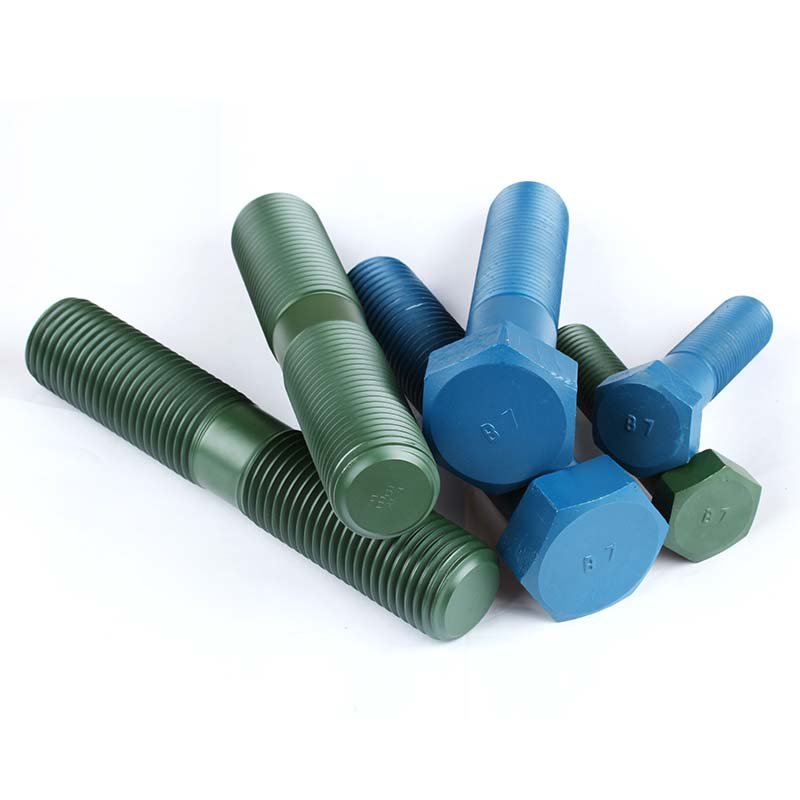PTFE Coating for Carbon Steel Fasteners
PTFE Coating for Fasteners: Comprehensive Surface Treatment for Carbon Steel
PTFE coating, or polytetrafluoroethylene coating, is a highly effective method used across the fastener industry to enhance the durability, corrosion resistance, and performance of carbon steel components. With increasing demand across sectors such as automotive, construction, and electronics, the application of PTFE coating has become a sought-after solution for extending fastener life and ensuring long-term reliability.
What is PTFE Coating?
Definition:
PTFE is a synthetic fluoropolymer of tetrafluoroethylene known for its non-stick properties, low friction coefficient, and excellent chemical resistance. In the context of surface treatment, PTFE coating involves applying a very thin layer—typically between 20µm and 40µm—onto fasteners to provide an anti-friction, corrosion-resistant barrier. The application process generally involves spraying, curing, and baking under specific temperature conditions.
Technical Background:
Originally developed by DuPont and popularized under the brand name Teflon, PTFE coatings were initially utilized in cookware and industrial machinery. It was later adapted for fasteners in corrosive environments like offshore oil rigs and chemical plants. As of today, PTFE is integral in various fastener performance-enhancement strategies, particularly for carbon steel components requiring extended exposure durability.
Common Applications and Suitable Fastener Types
| Fastener Types | PTFE Coated Suitability |
|---|---|
| Hex Bolts | ✅ Yes |
| Nuts | ✅ Yes |
| Self-tapping Screws | ✅ Yes |
| Washers | ✅ Yes |
| Threaded Rods | ✅ Yes |
| Industry Applications | Use-Cases |
|---|---|
| Automotive | Suspension systems, engines, and body frame |
| Construction | Bridges, coastal buildings, outdoor fixtures |
| Marine | Offshore platforms, ships, ports |
| Electronics | PCB mounting, grounding systems |
| Aerospace | Structural parts exposed to varying climates |
Performance Characteristics of PTFE-Coated Fasteners
Corrosion Resistance
PTFE coatings provide top-tier salt-spray resistance—often over 1,000 hours in ASTM B117 tests, making them ideal for coastal or corrosive environments.
Aesthetic and Finish
Typically available in colors like blue, green, or black, PTFE coatings provide a uniform matte finish with a smooth, non-stick surface. This enhances both function and visual appearance.
Surface Hardness
While PTFE is not a hard coating like phosphate or ceramic, it offers good abrasion resistance due to its slippery properties, minimizing galling and thread locking.
Conductivity
PTFE is inherently non-conductive, making it suitable for applications where electrical insulation is critical.
PTFE Coating Process Overview
| Stage | Description |
|---|---|
| Surface Preparation | Degreasing, rust removal, and grit-blasting to create bonding surface |
| Coating Application | Spray or dip coating with PTFE material |
| Curing | Baking at high temperatures (typically around 350°C) to set the PTFE layer |
| Post-treatment | Inspection, threading touch-ups, and package sealing |
Advantages and Limitations of PTFE Coating
Advantages:
- Excellent resistance to chemicals and corrosive agents
- Low-friction surface reduces galling
- Ideal for carbon steel, increasing its lifespan in adverse environments
- Consistent performance under a wide temperature range (-200°C to 260°C)
- Water and dirt repellent, reducing maintenance needs
Limitations:
- Higher processing costs compared to basic zinc plating
- Non-conductive, not suitable for grounding applications
- Requires specialized equipment and strict environmental controls
Comparative Analysis: PTFE Coating vs. Zinc Plating
| Feature | PTFE Coating | Zinc Plating |
|---|---|---|
| Corrosion Resistance | Superior (1000+ hours salt spray) | Moderate (72 – 96 hours) |
| Cost | High | Low |
| Conductivity | Non-conductive | Conductive |
| Aesthetic | Colored matte finishes | Shiny and metallic |
| Durability | Long-term in harsh environments | Moderate under controlled exposure |
PTFE is the go-to solution for applications requiring long-term reliability, especially in marine or chemical industries, while zinc plating suffices for short-term or indoor environments.
Industry Standards and Environmental Considerations
PTFE coatings comply with industry-specific standards, including:
- ASTM D2527: Standard Specification for PTFE Coatings
- MIL-PRF-46010: Military performance standards for PTFE films
- RoHS compliance: PTFE doesn’t use harmful hexavalent chromium
Environmental aspects are positive, as modern PTFE formulations minimize VOC emissions and avoid hazardous heavy metals.
Economic Outlook and Lifecycle Value
Despite higher initial processing costs, PTFE-coated fasteners bring long-term economic value by reducing replacement cycles, downtime, and maintenance. For critical projects, particularly involving carbon steel, the lifecycle cost advantage of PTFE is substantial.
In Summary
At Flybear Fastener, we believe that advanced surface treatments like PTFE coating are essential for maximizing the performance and service life of carbon steel fasteners. Whether you’re in construction, automotive, or the marine industry, our fastener products are designed to perform reliably in the toughest environments.
We provide both standard and customized solutions tailored to industry-specific needs. We invite you to explore our wide product selection and contact us for personalized support, technical advice, or a competitive quote.








